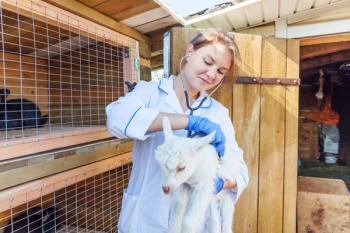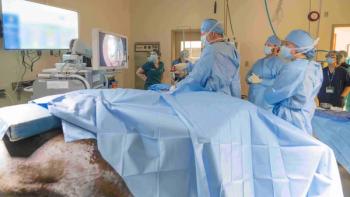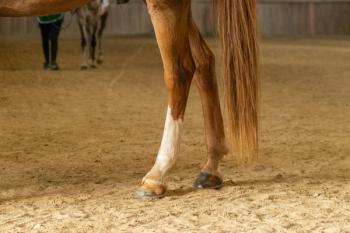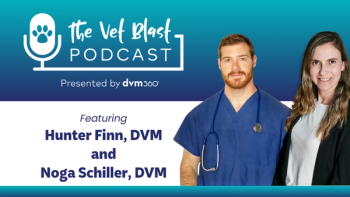
Contagious equine metritis probe involves 45 states
National Report - Investigators tracing a wide-ranging outbreak of contagious equine metritis (CEM) made important discoveries and took steps to halt the infectious reproductive disease, but after nearly two months the origin remains elusive and quarantines and testings continue.
National Report — Investigators tracing a wide-ranging outbreak of contagious equine metritis (CEM) made important discoveries and took steps to halt the infectious reproductive disease, but after nearly two months the origin remains elusive and quarantines and testings continue.
Hygiene protocols for horse handlers
At press time, 10 stallions had tested positive in four states (two in Wisconsin, four in Kentucky, three in Indiana and one in Texas) and were undergoing the standard treatment protocol.
Besides the 10 positive stallions, the locations of 433 exposed horses — 389 mares and 54 stallions — were confirmed in 45 states, and 65 CEM-exposed mares were still being traced, according to the US. Department of Agriculture's Animal and Plant Health Inspection Service (APHIS).
An exposed horse is defined by APHIS as one that was on the index premises — in this case DeGraff Stables/Liberty Farm Equine Reproduction Center LLC, Midway, Ky. — where the first positive stallion was identified in December, or one that was bred to a CEM-positive horse, naturally or via artificial insemination.
One of the most recent and important findngs came in mid-January in Wisconsin, when a 13-year-old Friesian stallion that was imported from the Netherlands in 2004 tested positive for Taylorella equigenitalis, the CEM causative bacterium.
Identified as Nanning 374, the stallion passed its importation quarantine in early 2005 and was in California until being moved to Wisconsin in the fall of 2006. During the 2007 breeding season, Nanning 374 and one of the currently positive stallions from Indiana went through the same artificial-insemination facility in Wisconsin, after which the Indiana stallion spent time at the index premises in Kentucky. It then went to Indiana for the 2008 season. The Texas stallion also spent time at the Kentucky premises.
That's enough to conclude that the disease introduction into Kentucky, where the first positive in a Quarter Horse stallion was reported Dec. 10, is now identified, says Rusty Ford, equine programs manager in the office of Robert Stout, DVM, Kentucky's state veterinarian. Still, investigation and testings continue in Kentucky.
"It isn't likely anyone will ever know which horse was infected first. Did the Friesian infect the Indiana horse (perhaps through the artificial-insemination equipment), or was it the other way around? It would take much more intensive detective work, and even then it may never be known," says Donna Gilson, a spokesperson for Wisconsin's Department of Agriculture, Trade and Consumer Protection.
"Investigators trace an outbreak backward and forward, but finding the original source is highly improbable," she says.
The owner of the Wisconsin artificial-insemination business and everyone else involved cooperated fully with Robert Ehlenfeldt, DVM, Wisconsin's state veterinarian, who heads the Division of Animal Health, Gilson says.
"It's to everyone's advantage to cooperate. When the door to trade closes in one state, it closes in others, and no one wants that to go on very long. Also, there's the cost factor," Gilson says, adding that Ehlenfeldt and his veterinary staff "have a seamless relationship with the USDA. When a government vet comes to a farm, often the owner doesn't know if it's a state or a federal vet."
In Kentucky, proactive steps taken at the index premises, along with timely communication with clients and state officials, made for a smooth and effective investigation, Ford says.
The first positive was confirmed during routine testing prior to a semen shipment to Europe. Three more stallions on the Kentucky property tested positive days later, as did three Indiana stallions that had spent time on the premises in 2008.
"Though never expecting to identify a foreign animal disease in a population of horses such as this, the Kentucky Department of Agriculture, under leadership of Commissioner Richie Farmer, has spent considerable time and effort in planning for the unexpected," says Ford. "This event demonstrates the efficacy of this planning and preparation."
"The (Kentucky) farm should be commended. The owners and staff have been very transparent, and worked well with the government and their clients. Had they not done so, we might have seen a much worse situation," Linda Mettel, a veterinarian at the New York State Animal Health Diagnostic Center at Cornell University's College of Veterinary Medicine, tells DVM Newsmagazine.
Still, veterinarians and anyone else who handles breeding mares or stallions, should follow strict hygienic practices, Mettel says.
She issued a news release listing basic practices that should be observed to help prevent the spread of CEM or other infectious diseases.
The United States has been considered free of CEM since the late 1970s. It is reported in about 25 other countries. The disease usually causes temporary infertility and, in rare cases, abortions. It is transmitted during breeding or through artificial insemination.
CEM is treated with disinfectants and antibiotics. CEM-positive mares, and mares imported from CEM-postive countries, must undergo treatment and remain in quarantine at least 21 days. Stallions infected with CEM or come from such countries must be quarantined throughout a full treatment regimen and then test negative for the disease.
In Kentucky, prior to a stallion's being declared free of the disease, it must undergo a test breeding process that calls for two mares to be bred, then cultured and test negative twice, Ford explains.
"Our investigation so far has found no evidence that the disease spread outside the identified populations; thus this event will have no effect on our signature Thoroughbred industry or the 2009 breeding season," he says.
Newsletter
From exam room tips to practice management insights, get trusted veterinary news delivered straight to your inbox—subscribe to dvm360.




